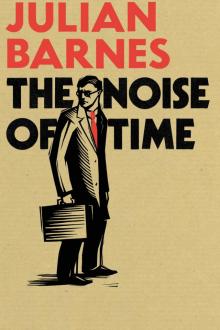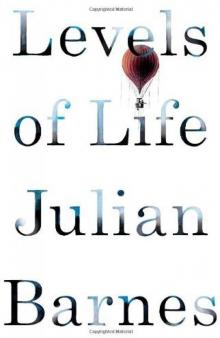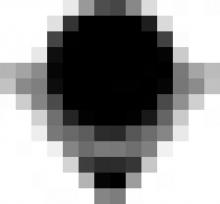- Home
- Julian Barnes
Levels of Life
Levels of Life Read online
CONTENTS
COVER
ABOUT THE BOOK
ABOUT THE AUTHOR
DEDICATION
TITLE PAGE
THE SIN OF HEIGHT
ON THE LEVEL
THE LOSS OF DEPTH
COPYRIGHT
About the Book
‘You put together two things that have not been put together before. And the world is changed…’
Julian Barnes’s new book is about ballooning, photography, love and grief; about putting two things, and two people, together, and about tearing them apart. One of the judges who awarded him the 2011 Man Booker Prize described him as ‘an unparalleled magus of the heart’. This book confirms that opinion.
About the Author
Julian Barnes was born in Leicester and moved to London in 1946. He is the author of twenty books, and in 2011 won the Man Booker Prize for The Sense of an Ending. He met Pat Kavanagh in 1978
Pat Kavanagh was born in South Africa and moved to London in 1964. She worked in advertising and then, for forty years, as a literary agent. She married Julian Barnes in 1979, and died in 2008.
for Pat
THE SIN OF HEIGHT
You put together two things that have not been put together before. And the world is changed. People may not notice at the time, but that doesn’t matter. The world has been changed nonetheless.
Colonel Fred Burnaby of the Royal Horse Guards, member of the Council of the Aeronautical Society, took off from the Dover Gasworks on the 23rd of March 1882, and landed halfway between Dieppe and Neufchâtel.
Sarah Bernhardt had taken off from the centre of Paris four years previously, and landed near Emerainville in the département of Seine-et-Marne.
Félix Tournachon had taken off from the Champ de Mars in Paris on the 18th of October 1863; after being driven east by a gale for seventeen hours, he crash-landed close to a railway line near Hanover.
Fred Burnaby travelled alone, in a red-and-yellow balloon called The Eclipse. Its basket was five feet long, three feet wide and three feet high. Burnaby weighed seventeen stone, wore a striped coat and a close skullcap, and to protect his neck from the sun made a puggaree of his handkerchief. He took with him two beef sandwiches, a bottle of Apollinaris mineral water, a barometer to measure altitude, a thermometer, compass, and a supply of cigars.
Sarah Bernhardt travelled with her artist–lover Georges Clairin and a professional aeronaut in an orange balloon called Doña Sol, after her current role at the Comédie-Française. At six thirty in the evening, an hour into their flight, the actress played mother, preparing tartines de foie gras. The aeronaut opened a bottle of champagne, firing the cork into the sky; Bernhardt drank from a silver goblet. Then they ate oranges and tossed the empty bottle into the Lake of Vincennes. In their sudden superiority, they cheerfully dropped ballast on to the groundlings below: a family of English tourists on the balcony of the Bastille Column; later, a wedding party enjoying a rural picnic.
Tournachon travelled with eight companions in an aerostat of his own boastful imagining: ‘I shall make a balloon – the Ultimate Balloon – of extraordinarily gigantic proportions, twenty times bigger than the biggest.’ He called it The Giant. It made five flights between 1863 and 1867. Passengers on this second flight included Tournachon’s wife Ernestine, the aeronaut brothers Louis and Jules Godard, and a descendant of the primal ballooning family of Montgolfier. It is not reported what food they took with them.
These were the balloon-going classes of the day: the enthusiastic English amateur, happy to be mocked as a ‘balloonatic’, and prepared to climb into anything about to become airborne; the most famous actress of her era, making a celebrity flight; and the professional balloonist who launched The Giant as a commercial venture. Two hundred thousand spectators watched its first ascent, for which thirteen passengers each paid one thousand francs; the aerostat’s cradle, which resembled a two-storey wicker cottage, contained a refreshment room, beds, a lavatory, a photographic department, and even a printing room to produce instant commemorative brochures.
The Godard brothers were everywhere. They designed and built The Giant, and after its first two flights brought it to London for exhibition at the Crystal Palace. Shortly afterwards a third brother, Eugène Godard, brought over an even bigger fire balloon, which made two ascents from Cremorne Gardens. Its cubic capacity was twice that of The Giant, while its straw-fed furnace, together with chimney, weighed 980 lb. On its first London flight, Eugène agreed to take one English passenger with him, at a charge of five pounds. That man was Fred Burnaby.
These balloonists happily conformed to national stereotype. Becalmed above the English Channel, Burnaby, ‘careless of the escaping gases’, lights a cigar to help him think. When two French fishing boats signal for him to descend and be picked up from the water, he responds ‘by dropping a copy of The Times for their edification’ – hinting, presumably, that a practical English officer can manage perfectly well by himself, thank you, Mossoo. Sarah Bernhardt confesses that she is temperamentally drawn to ballooning because ‘my dreamy nature would constantly transport me to the higher regions’. On her short flight she is provided with the convenience of a plain, straw-seated chair. When publishing her account of the adventure, Bernhardt whimsically opts to tell it from the chair’s point of view.
The aeronaut would descend from the heavens, look for a flat landing place, pull on the valve-line, throw out the grapnel, and often bounce forty or fifty feet back into the air before the flukes of the anchor took hold. Then the local population would come running. When Fred Burnaby landed near the Château de Montigny, an inquisitive rustic poked his head into the half-deflated gasbag, and nearly suffocated. The locals willingly helped collapse and fold the balloon; and Burnaby found these poor French labourers much kinder and more courteous than their English equivalents. He disbursed a half-sovereign in their direction, pedantically specifying the exchange rate at the time he had left Dover. A hospitable farmer, M Barthélemy Delanray, offered to put the aeronaut up for the night. First, though, came Mme Delanray’s dinner: omelette aux oignons, sautéed pigeon with chestnuts, vegetables, Neufchâtel cheese, cider, a bottle of Bordeaux and coffee. Afterwards, the village doctor arrived, and the butcher with a bottle of champagne. Burnaby lit a fireside cigar and reflected that ‘a balloon descent in Normandy was certainly preferable to one in Essex’.
Near Emerainville, the peasants who chased after the descending balloon marvelled to see that it contained a woman. Bernhardt was used to making entrances: did she ever make a grander one than this? She was, of course, recognised. The rustics duly entertained her with a drama of their own: the tale of a grisly murder recently committed just there, exactly where she sat (on her listening and narrating chair). Soon, it came on to rain; the actress, famous for her slimness, joked that she was too thin to get wet – she would simply slip between the drops. Then, after the ritual distribution of tips, the balloon and its crew were escorted to Emerainville station in time for the last train back to Paris.
They knew it was dangerous. Fred Burnaby nearly collided with the gasworks chimney shortly after take-off. The Doña Sol nearly came down in a wood shortly before landing. When The Giant crashed close to the railway line, the experienced Godards prudently jumped out before the final impact; Tournachon broke a leg, and his wife suffered injuries to her neck and chest. A gas balloon might explode; a fire balloon, unsurprisingly, could catch fire. Every take-off and landing was hazardous. Nor did larger mean safer: it meant – as the case of The Giant proved – more at the mercy of the wind. Early cross-Channel aeronauts often wore cork buoyancy jackets in case they landed on water. And there were no parachutes. In August 1786 – ballooning’s infancy – a young man had dropped to his death in Newcast
le from a height of several hundred feet. He was one of those who held the balloon’s restraining ropes; when a gust of wind suddenly shifted the airbag, his companions let go, while he held on and was borne upwards. Then he fell back to earth. As one modern historian puts it: ‘The impact drove his legs into a flower bed as far as his knees, and ruptured his internal organs, which burst out on to the ground.’
Aeronauts were the new Argonauts, their adventures instantly chronicled. A balloon flight linked town and country, England and France, France and Germany. Landing provoked pure excitement: a balloon brought no evil. By the Normandy fireside of M Barthélemy Delanray, the village doctor proposed a toast to universal brotherhood. Burnaby and his new friends clinked glasses. At which point, being British, he explained to them the superiority of a monarchy over a republic. But then, the president of the Aeronautical Society of Great Britain was His Grace the Duke of Argyll, and its three vice presidents were His Grace the Duke of Sutherland, the Rt Hon. the Earl of Dufferin, and the Rt Hon. Lord Richard Grosvenor MP. The equivalent French body, the Société des Aéronautes, founded by Tournachon, was more democratic and intellectual. Its aristocrats were writers and artists: George Sand, Dumas père et fils, Offenbach.
Ballooning represented freedom – yet a freedom subservient to the powers of wind and weather. Aeronauts often couldn’t tell if they were moving or stationary, gaining height or losing it. In the early days, they would throw out a handful of feathers, which would fly upwards if they were descending, and down if ascending. By Burnaby’s time this technology had advanced to torn-up strips of newspaper. As for measuring horizontal progress, Burnaby invented his own speedometer, consisting of a small paper parachute attached to fifty yards of silk line. He would toss the parachute overboard and time how long it took for the line to run out. Seven seconds translated into a balloon speed of twelve miles per hour.
There were multiple attempts, over that first century of flight, to master this uncontrollable bag with its dangling basket. Rudders and oars were tried, pedals and wheels turning screw-fans; they all made slight difference. Burnaby believed that shape was the key: an aerostat in the form of a tube or cigar, and propelled by machinery, was the way forward – as it eventually proved. But all, whether English or French, conservative or progressive, agreed that the future of flight lay in the heavier-than-air machine. And though his name was always linked to ballooning, Tournachon also founded the Society for the Encouragement of Aerial Locomotion by Means of Heavier-than-Air Machines; its first secretary was Jules Verne. Another enthusiast, Victor Hugo, said that a balloon was like a beautiful, drifting cloud – whereas what humanity needed was the equivalent of that gravity-defying miracle, the bird. Flight, in France, was generally a matter for social progressives. Tournachon wrote that the three supreme emblems of modernity were ‘photography, electricity and aeronautics’.
In the beginning, birds flew, and God made the birds. Angels flew, and God made the angels. Men and women had long legs and empty backs, and God had made them like that for a reason. To mess with flight was to mess with God. It was to prove a long struggle, full of instructive legends.
For instance, the case of Simon Magus. The National Gallery in London owns an altarpiece by Benozzo Gozzoli; its predella has been broken up and dispersed over the centuries. One section illustrates the story of St Peter, Simon Magus and the Emperor Nero. Simon was a magician who had won Nero’s favour, and sought to keep it by proving that his powers were greater than those of the apostles Peter and Paul. This tiny painting tells the story in three parts. In the background is a wooden tower, from which Simon Magus is demonstrating his latest trick: human flight. Vertical take-off and lift have been achieved, and the Roman aeronaut is seen heading skywards, with only the bottom half of his green mantle showing; the rest is cut off by the picture’s top edge. Simon’s secret rocket fuel is, however, illegitimate: he relies – physically as well as spiritually – on the support of demons. In the mid-ground, St Peter is shown praying to God, asking Him to dispossess the demons of their power. The theological and aeronautical results of this intervention are confirmed in the foreground: a dead magician, blood oozing from his mouth after an enforced crash-landing. The sin of height is punished.
Icarus messed with the Sun God: that was a bad idea too.
The first ever ascent in a hydrogen balloon was made by the physicist Dr J. A. C. Charles on the 1st of December 1783. ‘When I felt myself escaping from the earth,’ he commented, ‘my reaction was not pleasure but happiness.’ It was ‘a moral feeling’, he added. ‘I could hear myself living, so to speak.’ Most aeronauts felt something like that, even Fred Burnaby, who made a point of not rising easily to rapture. High above the English Channel, he observes the steam from the Dover and Calais packet boat, reflects on the latest foolish and abominable plan to build a Channel tunnel, then is moved, briefly, to moral feeling:
The air was light and charming to breathe, free as it was from the impurities that burden the atmosphere near the globe. My spirits rose. It was pleasant to be for the time in a region free from letters, with no post office near, no worries, and above all no telegraphs.
Aboard the Doña Sol, ‘the Divine Sarah’ is in heaven. She finds that up above the clouds there is ‘not silence, but the shadow of silence’. She feels the balloon to be ‘the emblem of uttermost freedom’ – which is also how most groundlings would have viewed the actress herself. Félix Tournachon describes ‘the silent immensities of welcoming and beneficent space, where man cannot be reached by any human force or by any power of evil, and where he feels himself live as if for the first time’. In this silent, moral space, the aeronaut experiences health of body and health of soul. Altitude ‘reduces all things to their relative proportions, and to the Truth’. Cares, remorse, disgust become strangers: ‘How easily indifference, contempt, forgetfulness drop away … and forgiveness descends.’
The aeronaut could visit God’s space – without the use of magic – and colonise it. And in doing so, he discovered a peace that didn’t pass understanding. Height was moral, height was spiritual. Height, some thought, was even political: Victor Hugo believed, quite simply, that heavier-than-air flight would lead to democracy. When The Giant crashed near Hanover, Hugo offered to raise a public subscription. Tournachon refused out of pride, so instead the poet composed an open letter in praise of aeronautics. He described walking in the Avenue de l’Observatoire in Paris with the astronomer François Arago when a balloon launched from the Champ de Mars passed over their heads. Hugo had said to his companion: ‘There floats the egg waiting for the bird. But the bird is within and will emerge.’ Arago took Hugo’s hands and replied ardently, ‘And on that day Geo will be called Demos!’ Hugo endorsed this ‘profound remark’, by saying, ‘“Geo will become Demos.” The whole world will be a democracy … Man will become bird – and what a bird! A thinking bird. An eagle with a soul!’
This sounds high-flown, overinflated. And aeronautics did not lead to democracy, unless budget airlines count. But aeronautics purged the sin of height, otherwise known as the sin of getting above yourself. Who now had the right to look down on the world from above and command its description? It is time to bring Félix Tournachon into better focus.
He was born in 1820 and died in 1910. He was a tall, gangling figure with a mane of red hair, passionate and restless by nature. Baudelaire called him ‘an astonishing expression of vitality’; his gusts of energy and flames of hair seemed enough to lift a balloon into the air by themselves. No one ever accused him of being sensible. The poet Gérard de Nerval introduced him to the magazine editor Alphonse Karr with the words, ‘He is very witty and very stupid.’ A later editor and close friend, Charles Philipon, called him ‘a man of wit without a shadow of rationality … His life has been, still is, and always will be incoherent.’ He was the sort of bohemian who lived with his widowed mother until he married; and the sort of husband whose infidelities coexisted with uxoriousness.
He was a journalist,
caricaturist, photographer, balloonist, entrepreneur and inventor, a keen registerer of patents and founder of companies; a tireless self-publicist, and in old age a prolific writer of unreliable memoirs. As a progressive, he hated Napoleon III, and sulked in his carriage when the Emperor arrived to watch the departure of The Giant. As a photographer, he declined the custom of high society, preferring to memorialise the circles in which he moved; naturally, he photographed Sarah Bernhardt several times. He was an active member of the first French society for the protection of animals. He used to make rude noises at policemen and disapproved of prison (where he had once been confined for debt): he thought juries should ask not ‘Is he guilty?’ but rather ‘Is he dangerous?’ He threw huge parties and kept open table; he gave over his studio on the Boulevard des Capucines to the first Impressionist exhibition of 1874. He planned to invent a new sort of gunpowder. He also dreamed of a kind of talking picture, which he called ‘an acoustic daguerreotype’. He was hopeless with money.
He was not known by the sturdy Lyonnais name of Tournachon. In the bohemia of his youth, friends were often affectionately rebaptised – for instance, by adding or substituting the suffix -dar. So he became first Tournadar, and then simply Nadar. It was as Nadar that he wrote and caricatured and photographed; as Nadar that he became, in the years between 1855 and 1870, the finest portrait photographer yet seen. And this was his name when, in the autumn of 1858, he put together two things that had not been put together before.

 The Sense of an Ending
The Sense of an Ending The Noise of Time
The Noise of Time Metroland
Metroland Letters From London
Letters From London Before She Met Me
Before She Met Me Pulse
Pulse Flaubert's Parrot
Flaubert's Parrot England, England
England, England The Porcupine
The Porcupine The Only Story
The Only Story Love, Etc
Love, Etc Through the Window: Seventeen Essays and a Short Story
Through the Window: Seventeen Essays and a Short Story Staring at the Sun
Staring at the Sun Cross Channel
Cross Channel Levels of Life
Levels of Life Arthur & George
Arthur & George Love, Etc.
Love, Etc. A History of the World in 10 1/2 Chapters
A History of the World in 10 1/2 Chapters Something to Declare
Something to Declare Through the Window: Seventeen Essays and a Short Story (Vintage International)
Through the Window: Seventeen Essays and a Short Story (Vintage International)